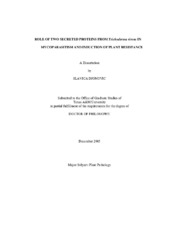| dc.description.abstract | The soil-borne filamentous fungus Trichoderma virens is a biocontrol agent with a well known ability to produce antibiotics, parasitize pathogenic fungi and induce systemic resistance in plants. Here we report the identification, purification and characterization of an elicitor secreted by T. virens; a small protein designated Sm1 (small protein 1). Confrontation and disk assays demonstrated that Sm1 lacks toxic activity against plants and microbes. Native, purified Sm1 triggers production of reactive oxygen species in rice (Oryza sativa) and cotton (Gossypium hirsutum), and induces the expression of defense related genes both locally and systemically in cotton. Gene expression analysis revealed that SM1 is expressed throughout fungal development and is transcriptionally regulated by nutrient conditions and the presence of a host plant. When T. virens was co-cultured with cotton in an axenic hydroponic system, SM1 expression and secretion of the protein was significantly higher than when the fungus was grown alone. These results indicate that Sm1 is involved in plant-Trichoderma recognition and the induction of resistance by activation of plant defense mechanisms. Following the cloning of SM1, strains disrupted in or over-expressing SM1 were generated. Targeted gene disruption revealed that SM1 was not involved in fungal development. Expression of defense related genes in cotton and maize (Zea mays) was induced locally and systemically following colonization by T. virens in the hydroponic system. Low levels of expression of cotton or maize defense genes were found when seedlings were grown with a T. virens strain disrupted in SM1, ssupporting the Sm1-elicitor hypothesis. Additionally, unique proteins in T.virens-cotton/maize interaction were identified. Thus, the induction of defense responses in two agriculturally important crops appears to be microbially mediated. Functional analysis of a cell wall degrading enzyme, beta-1,6-glucananse (Tv-bgn3) from T. virens, demonstrated involvement of this enzyme indirectly in mycoparasitic activity of T. virens. Protein extracts from the strain disrupted in TV-BGN3 displayed reduced capability to inhibit growth of Pythium ultimum as compared to the wild-type. Additionally, protein extracts from the strains co-expressed with TV-BGN2 (beta-1,3-glucananse) from T. virens showed a significantly increased capability to inhibit growth of P. ultimum and Rhizoctonia solani hyphae. | en |


